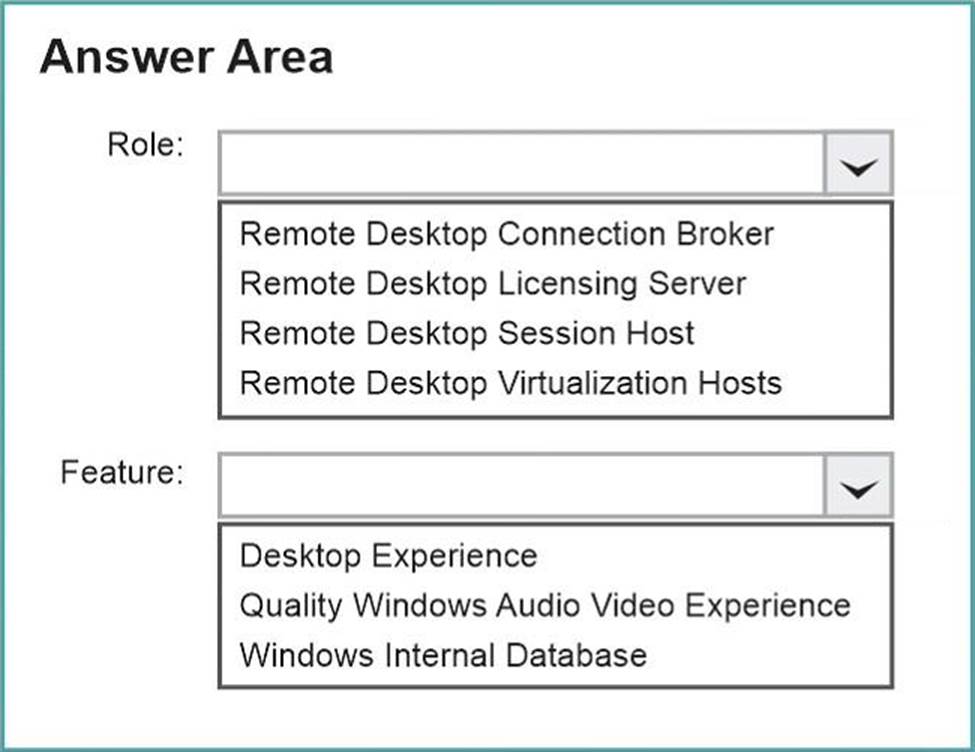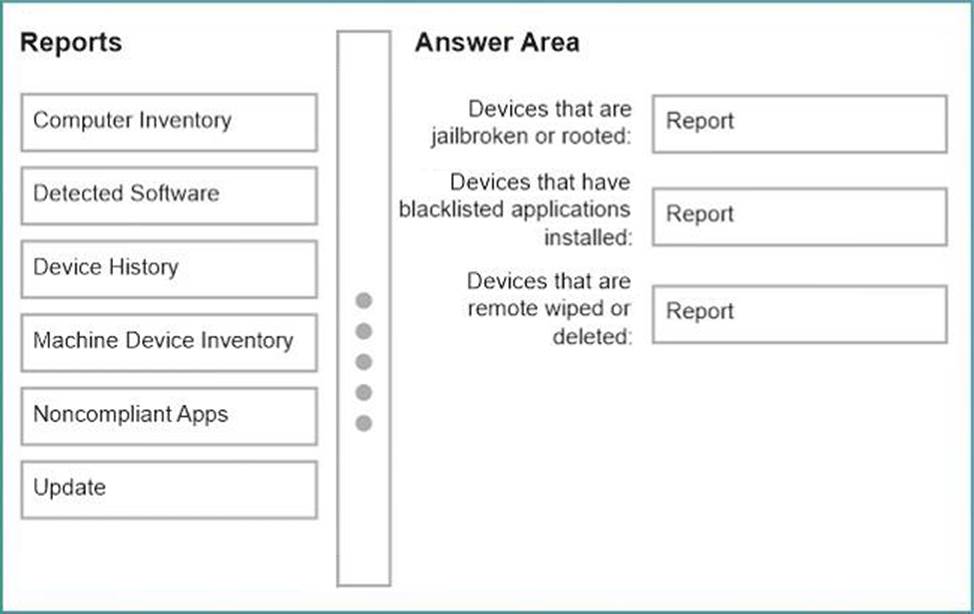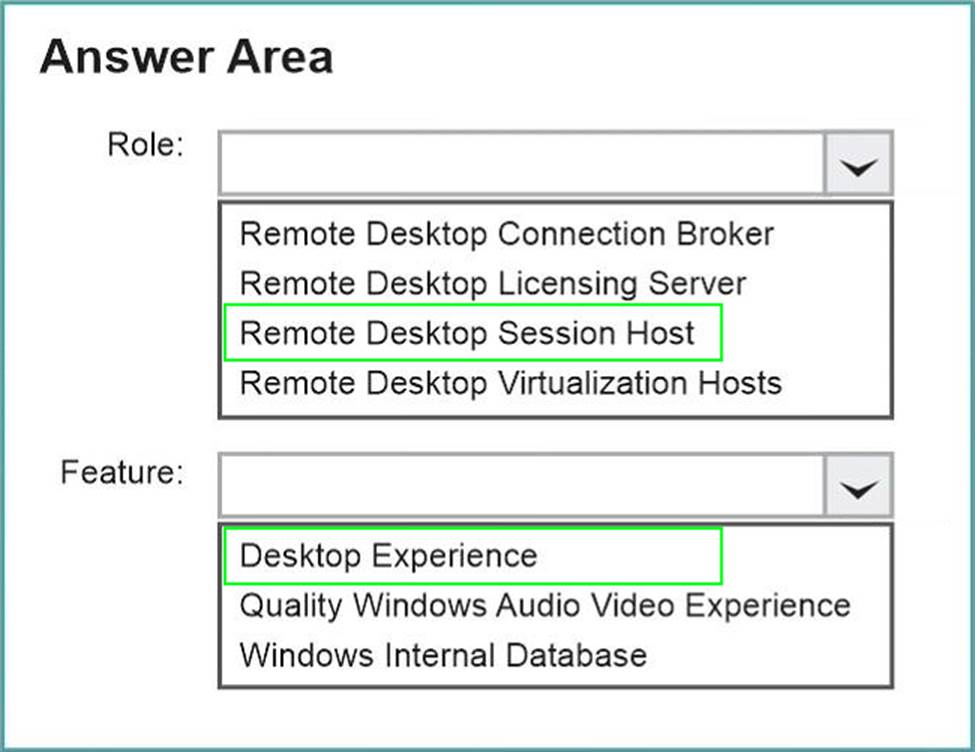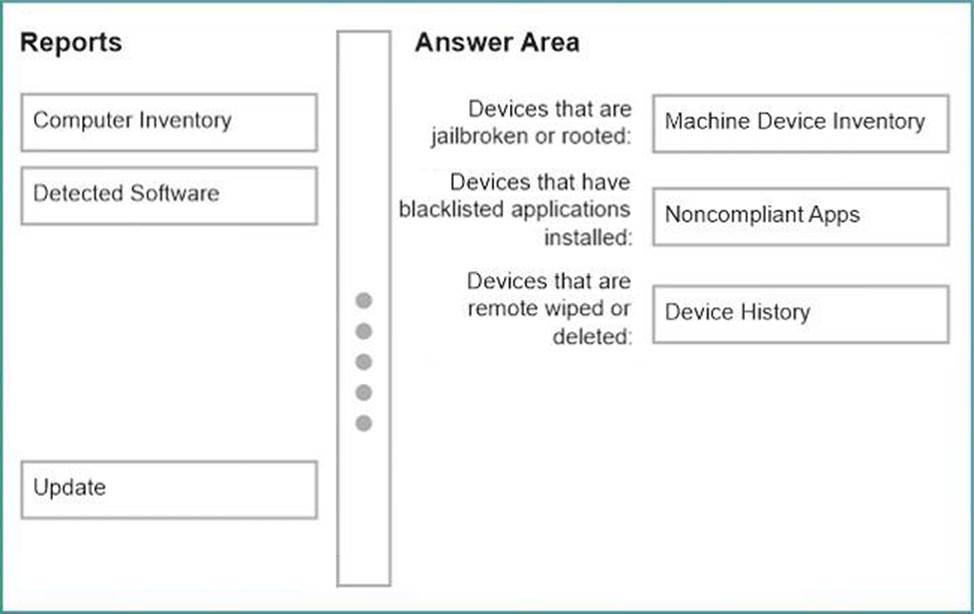Microsoft 70-697 Configuring Windows Devices Online Training
Microsoft 70-697 Online Training
The questions for 70-697 were last updated at Jan 05,2025.
- Exam Code: 70-697
- Exam Name: Configuring Windows Devices
- Certification Provider: Microsoft
- Latest update: Jan 05,2025
HOTSPOT
You plan to deploy a Microsoft Azure RemoteApp hybrid collection.
You plan to use a custom template image named Image1 to deploy the hybrid collection.
You need to identify the role and feature that must be enabled in the image to support the deployment of the hybrid collection.
What should you identify? To answer, select the appropriate options in the answer area.
NOTE: Each correct selection is worth one point.

You have a Microsoft Intune subscription.
You need to uninstall the Intune agent from a computer.
What should you do?
- A . From the Groups node in the Microsoft Intune administration portal, click Delete.
- B . From the computer, run the provisioningutil.exe command.
- C . From the computer, run the cltui.exe command.
- D . From the computer, use Programs and Features in Control Panel.
DRAG DROP
You have a Microsoft Intune subscription.
You need to identify devices based on the following requirements:
• Devices that are jailbroken or rooted
• Devices that are remote wiped or deleted.
• Devices that have blacklisted applications installed.
Which type of report should you use for each requirement? To answer, drag the appropriate reports to the correct requirements. Each report may be used once, more than once, are not at all. You may need to drag the split bar between panes or scroll to view content.

Your network contains an Active Directory domain named contoso.com. All users have email addresses in the @adatum.com domain.
You need to ensure that users can register Windows 10 mobile devices for mobile device management (MDM).
Which DNS record should you create?
- A . Enterpriseregistration.adatum.com
- B . Deviceregistration.adatum.com
- C . Deviceregistration.contoso.com
- D . Enterpriseregistration.contoso.com
You support Windows 10 Enterprise laptops. Microsoft BitLocker Administration and Monitoring (MBAM) is deployed on your network on a server named SERVER1.
Company policy requires that laptops with MBAM client installed prompt users to enable BitLocker within 2 hours of being started.
You need to make changes to the Configure MBAM Services Group Policy settings.
Which two actions should you perform? Each correct answer presents part of the solution.
- A . Set Select BitLocker Recovery Information to store to Recovery password only.
- B . Set Select BitLocker Recovery Information to store to Recovery password and key package.
- C . Set Enter status reporting frequency (in minutes) to 120.
- D . Set MBAM Status reporting endpoint to SERVER1.
- E . Set MBAM Recovery and Hardware service endpoint to SERVER1.
- F . Set Enter client checking status frequency (in minutes) to 120.
You purchase a new Windows 10 Enterprise desktop computer. You have six external USB hard drives.
You want to create a single volume by using the six USB drives. You want the volume to be expandable, portable, and resilient in the event of simultaneous failure of two USB hard drives.
You need to create the required volume.
What should you do?
- A . From Control Panel, create a new Storage Space across 6 USB hard drives. Set resiliency type to Parity.
- B . From Disk Management, create a new striped volume.
- C . From Disk Management, create a new spanned volume.
- D . From Control Panel, create a new Storage Space across 6 USB hard drives. Set resiliency type to Three-way mirror.
Note: This question is part of a series of questions that use the same or similar answer choices. An answer choice may be correct for more than one question in the series. Each question is independent of the other questions in this series. Information and details provided in a question apply only to that question.
You have a computer that runs Windows 10 and is used by 10 users. The computer is joined to an Active Directory domain. All of the users are members of the Administrators group. Each user has an Active Directory account.
You have a Microsoft Word document that contains confidential information.
You need to ensure that you are the only user who can open the document.
What should you configure?
- A . account policies
- B . application control policies
- C . HomeGroup settings
- D . software restriction policies
- E . NTFS permissions
- F . Microsoft OneDrive
- G . share permissions
- H . Encrypting File System (EFS) settings
Note: This question is part of a series of questions that use the same or similar answer choices. An answer choice may be correct for more than one question in the series. Each question is independent of the other questions in this series. Information and details provided in a question apply only to that question.
A user successfully accesses \server1SourcesApp1. The user cannot access \server1SourcesApp2.
You need to ensure that the user can access \server1SourcesApp2.
What should you configure?
- A . Microsoft OneDrive
- B . share permissions
- C . account policies
- D . software restriction policies
- E . HomeGroup settings
- F . application control policies
- G . NTFS permissions
- H . Encrypting File System (EFS) settings
Note: This question is part of a series of questions that use the same or similar answer choices. An answer choice may be correct for more than one question in the series. Each question is independent of the other questions in this series. Information and details provided in a question apply only to that question.
You have an application named App1 installed on a computer named Computer1. Computer1 runs Windows 10. App1 saves data to %UserProfile%App1Data.
You need to ensure that you can recover the App1 data if Computer1 fails.
What should you configure?
- A . share permissions
- B . application control policies
- C . Encrypting File System (EFS) settings
- D . NTFS permissions
- E . HomeGroup settings
- F . Microsoft OneDrive
- G . software restriction policies
- H . account policies
Note: This question is part of a series of questions that use the same or similar answer choices. An answer choice may be correct for more than one question in the series. Each question is independent of the other questions in this series. Information and details provided in a question apply only to that question.
You have a computer that runs Windows 10 and is used by 10 users. The computer is joined to an Active Directory domain. Each user has an Active Directory account.
You need to ensure that all of the users can access the files located in one another’s libraries.
What should you configure?
- A . Microsoft OneDrive
- B . HomeGroup settings
- C . Encrypting File System (EFS) settings
- D . NTFS permissions
- E . Account policies
- F . Share permissions
- G . Software restriction policies
- H . Application control policies
Latest 70-697 Dumps Valid Version with 339 Q&As
Latest And Valid Q&A | Instant Download | Once Fail, Full Refund



